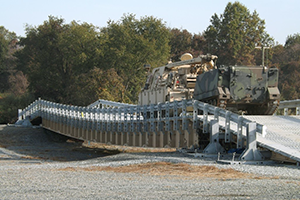The Long Reach of ATC
By Steven G. Hensley,
Senior Test Officer, Force Projection & Watercraft Branch, Warfighter Directorate

Bring it on! The M88 armored recovery vehicle tows an M113 personnel carrier across the LOCB. Military load classification for the LOCB is 120 wheeled/100 tracked in normal cross; 150 wheeled/120 tracked in caution cross.
In a war zone, where bridges are nonexistent or have been destroyed, the military bridge is critical to Soldier success and safety. Historically, tactical bridge deployment needed cranes and other equipment, plus a large crew - a liability in wartime. The Line of Communication Bridge (LOCB) will help our Soldiers advance under adversity with minimal crew, equipment, and time required.
The LOCB is the highest capacity bridge in the U.S. Army inventory. Its 4.2-meter-wide roadway consists of 50-meter segments, any of which will connect a 50-meter gap. All segments, linked and supported by intermediate piers installed by crane, will span gaps of up to 300 meters. To deploy, a series of rollers is placed on the near shore. The LOCB is fully assembled on top of the rollers. A vehicle with tow bar, attached to the bridge, provides the force to roll the bridge across the gap. Day or night, a typical crew of 29 Soldiers can complete a 50-meter bridge build, or bridge removal, in about 48 hours.
A separate pedestrian walkway can be bolted onto the bridge manually or by using a forklift or crane. The bridge segments and components are transportable worldwide inside 20-ft2 standard containers. The LOCB can support any vehicle in the Army inventory with capacity to spare. In fact, the entire length of the bridge could be covered with semitrailers with no excess weight problem.
Many bridges are built by commercial entities and sold to the Army: the LOCB is all-Army. Design, manufacture, and testing are performed by Army professionals. Developmental testing at ATC will determine LOCB effectiveness, suitability, and survivability. Testing will ensure the bridge is safe to build, can handle a wide range of vehicles, is transportable by standard commercial industry methods, and is durable enough for continual use in a war zone.
Many bridges are built by commercial entities and sold to the Army: the LOCB is all-Army. Design, manufacture, and testing are performed by Army professionals. Developmental testing at ATC will determine LOCB effectiveness, suitability, and survivability. Testing will ensure the bridge is safe to build, can handle a wide range of vehicles, is transportable by standard commercial industry methods, and is durable enough for continual use in a war zone.
Next up for the LOCB is a 100-meter-gap launch with the same series of vehicles as those used to cross the 50-meter gap. After the 100-meter test, the bridge will enter the Durability Test Phase. To determine the LOCB’s service life, the ATC Bridge Crossing Simulator (BCS) will replicate approximately 98,000 vehicle crossings. Simulated crossings match the strain profiles generated during live vehicle crossings and accomplish hundreds of crossings per day at much less cost to the customer than live testing. In the event of a “bridge failure,” the BCS shuts down without risk to personnel.
After durability testing, the U.S. Army Evaluation Center (AEC) will evaluate the results. Once approved by AEC, the LOCB will be fielded to Army Multi-Role Bridge Companies across the globe, further closing the gap between our Soldiers and the defeat of enemy obstacles.
You are now leaving www.atc.army.mil and entering another site. You will automatically be forwarded to the target page within five seconds.
